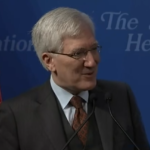A Primer On Liberty
GLEN COVE, NY—The idea that Englishmen had certain liberties that the King must respect was first put in writing by Henry I in 1100. It found expression in Saint Thomas a Becket’s defense of the liberty of the English clergy, for which he was martyred in 1170 at the instigation of Henry II. This idea was the foundation for one of the most important and least understood documents in the history of liberty, the original version of Magna Charta signed by King John in 1215 at the insistence of the barons and bishops at Runnymede. It was largely a list of promises to stop certain injustices he was committing, not only against the barons, but also against the rights of free cities, of the King of Scotland, and of free Englishmen in general.
By 1225, Henry III had watered down Magna Charta by eliminating many liberties when he re-promulgated it. The version that appeared for centuries in English law books was diluted even more.
Liberty as understood by Saint Thomas a Becket, the barons and bishops at Runnymede, and the medieval English people was not the liberty of “Liberty, Fraternity, Equality” or of the idea that all men are created equal. The liberty guaranteed by Magna Charta was the liberty of individuals, determined by their station in life, and of institutions such as the Church and the free cities. The idea was that all individuals had certain rights, some individually and some collectively, and that the violation of these rights by persons in power was contrary to law and morality. The modern idea that each person was born with the same rights was not yet invented; the rights each person had were determined by his station in life and his relations to other people.
The modern theory of liberty is that all men have a right to life, liberty, and property, or life, liberty, and the pursuit of happiness. This concept is derived from the fact that the main violations of the liberties of men are:
(1) killing them without a just conviction at a fair trial for a crime justly carrying the death penalty;
(2) imprisoning them without due process of law or illegally forcing them to perform labor; or
(3) taking away something that belongs to them.
These are, indeed, the very kind of things Magna Charta forbids.
The modern rhetoric of liberty, however, seldom accompanies true liberty. The Whigs were fond of talking about life, liberty, and property, but they were nasty practitioners of persecution. The French revolutionaries spoke of liberty, fraternity, and equality, but they put people to death by mob will.
The American Constitution marked a rebirth of liberty. It prohibited such obvious violations of liberty as ex post facto laws and bills of attainder. It required strict adherence to established English law before the federal government could kill, imprison, or fine anyone, or enter a judgment against him. On the other hand, it respected existing rights by leaving intact the peculiar legal relation between the patroons of New York and their agricultural tenants. It allowed Massachusetts and Connecticut to maintain their Calvinist state governments rather than entangle the federal government in religious questions.
This essay is excerpted from an article published by the Griffin Internet Syndicate.
Copyright (c) Charles G. Mills and the Fitzgerald Griffin Foundation. All rights reserved.
Charles G. Mills is the Judge Advocate or general counsel for the New York State American Legion. He has 40 years of experience in many trial and appellate courts and has published several articles about the law.
The FGF E-Package is made possible by donations
to the Fitzgerald Griffin Foundation, P.O. Box 1383,
Vienna, VA 22183.




